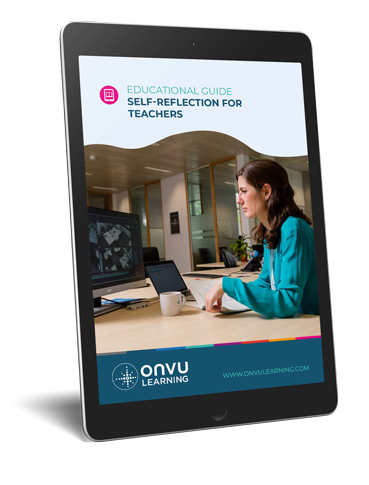- Teacher Professional Development
- 4 Minute Read



The world is changing and so must we.
 This is such a crucial question for a few key reasons. It is perfectly sensible to expect that someone whose chosen vocation is focused on enabling others to learn should want to learn new things themselves. No profession sits still and so teachers need and want to continuingly sharpen their skills to meet new and emerging demands. Secondly, a significant amount of time per year is dedicated to Continuous Professional Development (CPD). Time is often cited as the scarcest resources in schools and so time dedicated to CPD must be well spent.
This is such a crucial question for a few key reasons. It is perfectly sensible to expect that someone whose chosen vocation is focused on enabling others to learn should want to learn new things themselves. No profession sits still and so teachers need and want to continuingly sharpen their skills to meet new and emerging demands. Secondly, a significant amount of time per year is dedicated to Continuous Professional Development (CPD). Time is often cited as the scarcest resources in schools and so time dedicated to CPD must be well spent.
This is particularly important when some of the CPD time that a teacher has, includes occasions when no students are in school (INSET days/sessions), which means that the outcome an INSET day has to achieve (in simple terms) needs to be at least the equivalent to a student’s day of learning. Teacher development programmes therefore need to be planned out well in advance of any delivery so that any CPD activities achieve defined aims, which are shared and understood by teachers.
We need to have first identified a target to know whether we hit it.
Partly, this is because the range of activities that sit under the ‘CPD’ banner are many and varied; not all of them are continuous or developmental. Selecting the ‘right’ CPD at the right time for the right people means having a very clear and accurate sense of what will make the biggest difference in order to achieve a defined aim. A challenge is that very often CPD is conflated with ‘need for improvement’; in other words, CPD risks being approached from a position of deficit reduction instead of from a position of adding to existing strengths. This deficit perception of CPD is common in schools that I have come across where there is a lack of clear leadership vision and thus a lack of a clear CPD aim. This has meant that there is an underlying sense of misalignment or at worst, confusion about what any given CPD input is supposed to achieve for individuals or for the school.
By contrast, in schools where leaders’ vision for students and teachers’ development is clear and aligned to a positive culture of shared and continuous development, then the training that teachers engage in is purposeful and impactful. This scenario ultimately creates the environment necessary for long-term, sustained excellent student outcomes because of excellent teacher learning outcomes. In these schools, teacher CPD is considered part of the journey towards improving students’ outcomes and so time and resources that are invested return positive, defined results because leaders and teachers know what the difference will look like.
A brilliant example of this latter scenario has been where middle leaders in charge of curriculum areas have undertaken what was the National Professional Qualification for Middle Leadership (NPQML). I was a trained facilitator of this programme’s predecessor (Middle Leadership Development Programme) and what I noticed was that the course didn’t so much train ‘heads of’ on how to perform their role better but rather helped them identify specific opportunity areas that, with a little bit of CPD input for their teams, could make disadvantaged students’ outcomes improve. This resulted in some middle leaders choosing to dedicate department time on specific content that they identified was difficult for some students to access due to literacy barriers. In other cases, new resources were created that teachers were shown how to deploy at the right points in a scheme of work. Critically, the middle leaders were positioned as coaches for their teams while also being coached by the programme. The benefits of this programme were more effective middle leaders, teams and teaching and learning approaches.
“Any fool can know. The point is to understand.” Albert Einstein
 The simple answer is no. Firstly, the cause and effect relationship between any CPD input and an impact on teachers’ performance is often hard to determine, not least because of some of the challenges associated with evaluating teachers’ practice (as I discussed in my last blog). Secondly, it is hard to capture every CPD instance. For example, I would argue that any discussion between two teachers about how to deliver an activity is professional development (likely to be continuous as teachers talk together professionally, frequently) but that interaction is unlikely to be captured, analysed and evaluated in the same manner as a formally arranged CPD ‘session’. CPD requires a purpose which can be missing in schools where the culture of learning is limited to students and not extended to teaching staff. As such, the impact of the best designed CPD will be limited by the context in which it is happening if the school’s teacher development culture is poor. Finally, CPD’s impact is often measured in such a way as to attempt to link an input that a teacher has received on the outcome that a student achieves. While there are examples when a cause and effect relationship may be quite obvious (e.g. a teacher learns new content, delivers that to a class and students then know that content or skill, as assessed by an end of lesson quiz), it is often the case that students’ outcomes are not the straight forward consequence of their formal, timetabled lessons.
The simple answer is no. Firstly, the cause and effect relationship between any CPD input and an impact on teachers’ performance is often hard to determine, not least because of some of the challenges associated with evaluating teachers’ practice (as I discussed in my last blog). Secondly, it is hard to capture every CPD instance. For example, I would argue that any discussion between two teachers about how to deliver an activity is professional development (likely to be continuous as teachers talk together professionally, frequently) but that interaction is unlikely to be captured, analysed and evaluated in the same manner as a formally arranged CPD ‘session’. CPD requires a purpose which can be missing in schools where the culture of learning is limited to students and not extended to teaching staff. As such, the impact of the best designed CPD will be limited by the context in which it is happening if the school’s teacher development culture is poor. Finally, CPD’s impact is often measured in such a way as to attempt to link an input that a teacher has received on the outcome that a student achieves. While there are examples when a cause and effect relationship may be quite obvious (e.g. a teacher learns new content, delivers that to a class and students then know that content or skill, as assessed by an end of lesson quiz), it is often the case that students’ outcomes are not the straight forward consequence of their formal, timetabled lessons.
“Tell me and I forget. Teach me and I remember. Involve me and I learn”. Benjamin Franklin
Recently published research on effective CPD [e.g. the EFF] suggests that if CPD is well-structured and focused, then its impact on teachers’ effectiveness will improve when compared to alternatives. By defining what is and what isn’t CPD and then by measuring what is possible to reasonably measure against a defined target, it is possible to identify CPD approaches that are more likely to result in positive student impacts. Organisations, including those offering the ECF, ITT and NPQs such as Ambition Institute, Teacher Development Trust and Educational Development Trust, are good places to start looking for external input. Many Multi-academy Trusts have, or are developing, their own CPD programmes or frameworks, which means that teachers working with them are likely to benefit from CPD opportunities that do align to defined targets and will be sustained. The challenge is maintaining CPD inputs that build rather than one-off snippets of interesting but short-term gimmicks.
But when it all boils down, the real benefits of CPD revolve around simple human needs and wants. Teachers need to feel safe, nurtured and able to thrive. Effective CPD helps those. Teachers want to feel valued, trusted and good at what they do. Effective CPD support those. The real benefit of good CPD – brilliant teachers educating our children!
![]() Our educational guides are designed to give you knowledge and advice on a variety of educational topics.
Our educational guides are designed to give you knowledge and advice on a variety of educational topics.

Have you ever wondered if self-reflection can help your teaching? The Self-Reflection for Teachers guide discusses the benefits to your CPD programme, offers some practical tips and techniques and how you can build a culture of self-reflection in your school.
KEEP IN TOUCH WITH ONVU LEARNING AND RECEIVE THE LATEST NEWS ON EDTECH, LESSON OBSERVATION, AND TEACHER TRAINING AND DEVELOPMENT.